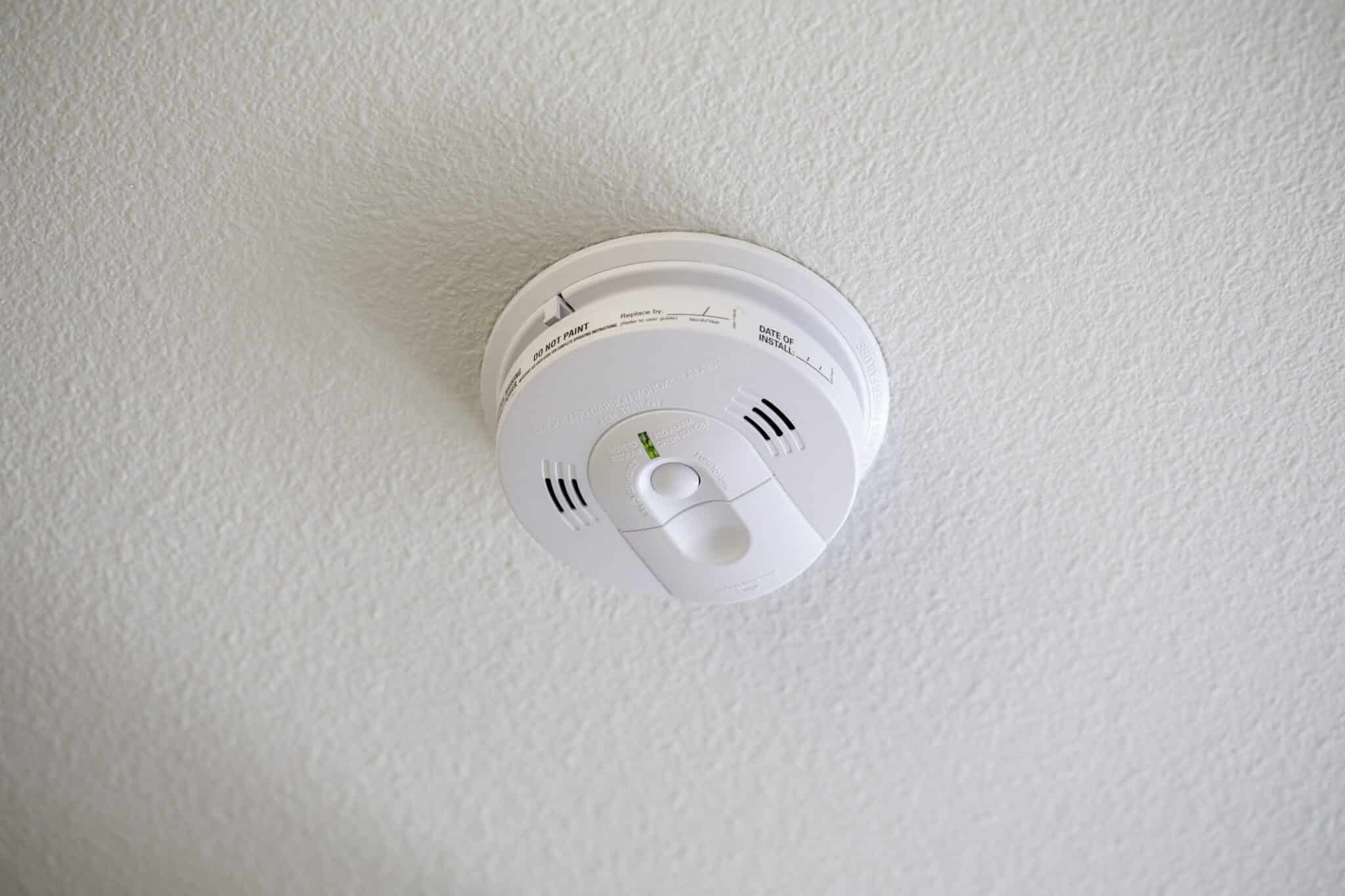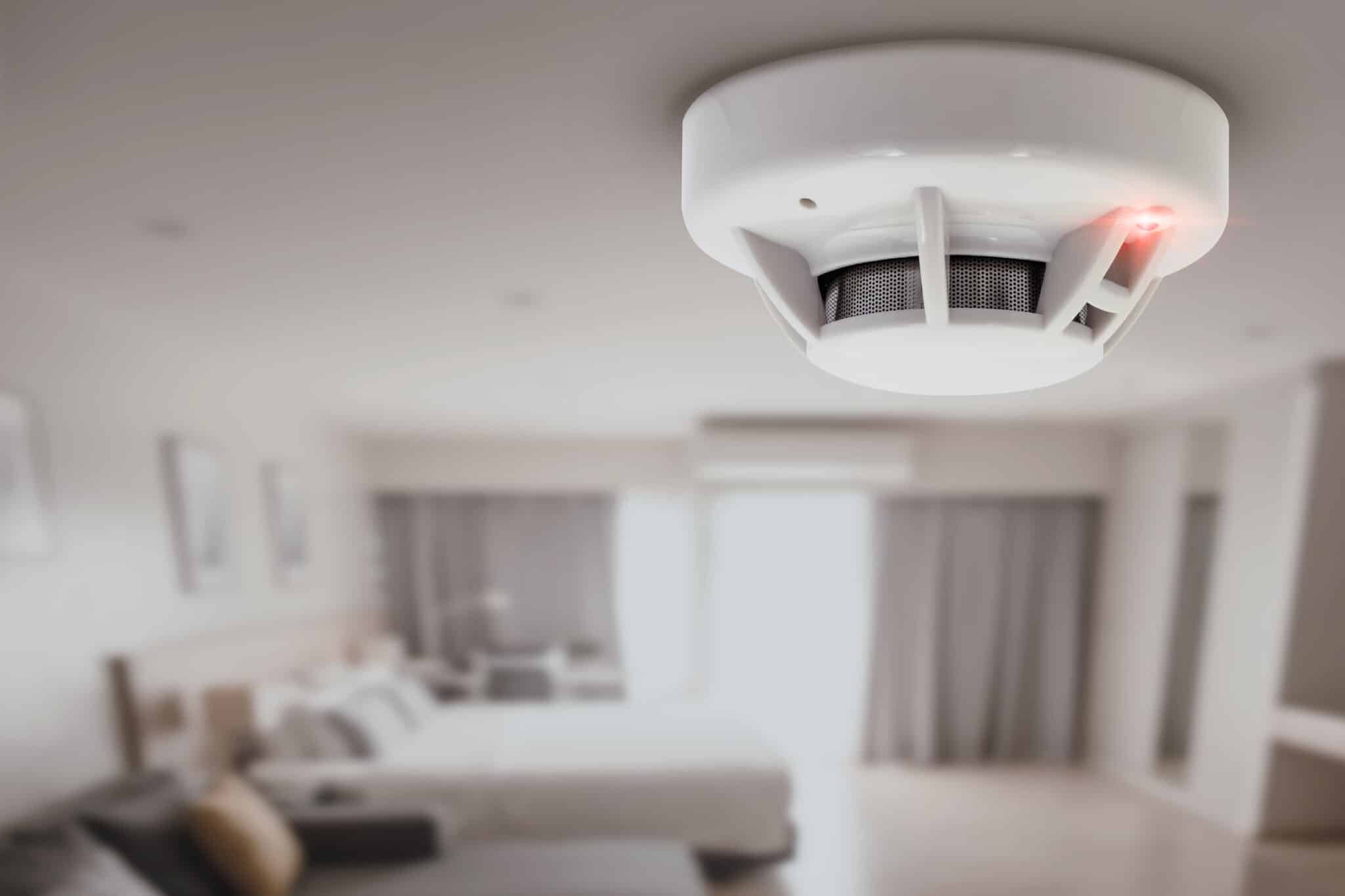Carbon monoxide detectors are key to keeping your home safe from carbon monoxide—a gas you can’t see or smell but can be deadly. Put detectors near bedrooms, follow NFPA rules, and test them often. This is especially important in winter when CO risks are higher.
Why Carbon Monoxide Detectors Matter
Did you know carbon monoxide is called the “silent killer” because you can’t see, smell, or taste it?
This deadly gas can become a serious threat, especially in the winter when heating systems run all the time.
Without proper detectors monitoring for carbon monoxide, your home could be at risk without you even knowing.
In Charleston, SC, where many homes use gas-powered heating or appliances, having a working CO detector isn’t just smart—it can save lives.
CO incidents rise in the colder months, often caused by faulty furnaces, fireplaces, or poor ventilation.
Even new appliances aren’t foolproof—things can break without warning.
Protecting your home starts with prevention.
Carbon monoxide detectors catch dangerous gas levels early, giving you time to act before things get worse.
Don’t wait for symptoms like headaches, dizziness, or nausea, which are easy to mistake for the flu.
A well-placed CO detector could be the difference between a safe home and a tragedy.
For ensuring proper installation and maintenance of carbon monoxide detectors, trust the experts at Mister Sparky of Charleston to help you safeguard your home.

Where Carbon Monoxide Comes From in Your Home
Carbon monoxide (CO) can come from many places in your home, especially during the colder months in Charleston, SC.
Malfunctioning heaters and improperly maintained furnaces often pose significant risks, as they may leak harmful gas into your living spaces.
Additionally, gas-powered appliances such as stoves, water heaters, and fireplaces can also release CO if not properly vented or serviced.
Other commonly overlooked sources include using space heaters that are not specifically designed for indoor use.
Starting a car or grill in a garage—even with the door partly open—can allow CO to build up and potentially seep into your home.
Blocked chimneys also present a danger, trapping hazardous gases that should be vented outside.
These risks increase during winter when heaters and fuel-burning appliances are used more frequently, and homes are sealed tightly to retain warmth.
Protect your family by scheduling regular maintenance for appliances and ensuring proper ventilation in your home.
Installing dependable carbon monoxide detectors is a vital step in guarding against this invisible danger.
Where to Put Carbon Monoxide Detectors in Your Charleston, SC Home
Placing carbon monoxide detectors in the right spots in your home is key to keeping your family safe.
These devices can’t just be placed anywhere—their location affects how well they work.
Start with bedrooms—this is a must.
Experts recommend having a detector within proximity of all sleeping areas to ensure the alarm is loud enough to wake everyone.
In homes with more than one floor, put a detector on each level, including the basement.
Don’t forget places like hallways or central spots where CO might build up.
Avoid common mistakes.
Place detectors on the walls or ceilings as the manufacturer’s instructions recommend, so they can catch CO effectively.
In rooms with gas stoves, fireplaces, or other appliances, keep detectors at a distance to avoid false alarms.
Charleston’s coastal weather can lead people to seal their homes tight in winter.
To ensure safety, make sure the devices aren’t placed near vents or windows where airflow might interfere with detection.
A properly placed detector isn’t just a device—it’s peace of mind for you and your family in Charleston, SC.
Where to Place Carbon Monoxide Detectors in Your Home
Placing carbon monoxide detectors in the right locations is essential for keeping your home safe.
For optimal performance, install detectors on walls at least 5 feet above the floor or on the ceiling, as carbon monoxide spreads evenly in the air.
Avoid placing them near appliances like stoves or heaters, as this might lead to false alarms caused by small emissions.
In large areas like living rooms or basements, consider using multiple devices to ensure full coverage.
Avoid drafts by keeping them away from windows, vents, or AC units, as airflow can interfere with their accuracy.
If you’re uncertain about the best placement for your home’s unique layout, contact professionals like Mister Sparky of Charleston in Charleston, SC.
A licensed electrician can ensure proper installation of carbon monoxide detectors for maximum safety.
The right placement makes all the difference.
Strategically positioning your devices can help keep you and your family safe all year long.
Tips for Choosing the Right Carbon Monoxide Detectors
Choosing the right carbon monoxide detector is essential for keeping your home in Charleston, SC, safe.
Start by considering the type of detector—plug-in, battery-operated, or hardwired models each offer unique advantages. Plug-in models are simple to install, battery-operated options continue working during power outages, and hardwired detectors, which are often interconnected, provide comprehensive coverage but usually require professional installation.
Ensure the detector has a UL (Underwriters Laboratories) or CSA (Canadian Standards Association) certification, which guarantees it meets rigorous safety standards.
Opting for a model with a digital display allows you to easily monitor CO levels.
Combination detectors that check for both smoke and carbon monoxide can add an extra layer of security in a single device.
Placement is also crucial.
Detectors with dual power (battery backup and plug-in) offer versatile installation options. For instance, place standalone models in bedrooms and interconnected ones in common areas or near stairways to ensure timely alerts.
Choosing the right carbon monoxide detectors gives you peace of mind while preparing your home for colder seasons.
If you’re unsure which option fits your needs or want it installed correctly, reach out to Mister Sparky of Charleston for expert guidance.
Why Your Carbon Monoxide Detector Is Beeping
A beeping carbon monoxide detector can be scary, but knowing why it’s beeping can help you act fast.
Low batteries are one of the most common reasons. If your detector chirps every 30 to 60 seconds, it’s likely time to change the batteries. Swap them out, and the beeping should stop.
Many detectors also have end-of-life signals to let you know when they’ve worn out, usually after 5-7 years. If that’s the case, you’ll need to replace the detector to stay safe.
If the beeping is an emergency alarm, this means there are dangerous levels of carbon monoxide in your home. Get everyone out right away and call 911 or the fire department. Don’t assume it’s a false alarm—wait for professionals to confirm your home is safe before going back inside.
Sometimes, the problem might be a device malfunction. This can happen if the sensor is dirty or the detector has expired. If changing the batteries and resetting the device doesn’t fix it, contact a professional electrician like Mister Sparky of Charleston. Don’t ignore a malfunctioning detector—it could put your household at risk.
Keep your carbon monoxide detectors functioning properly to protect your Charleston, SC home.
If you’re unsure about the safety or reliability of your alarms, reach out to Mister Sparky of Charleston for expert assistance in ensuring your home’s safety.
How to Test Your Carbon Monoxide Detectors
Testing your carbon monoxide detectors is crucial to keeping your home and family safe.
Follow these easy, safe steps to make sure they work when you need them:
- Find the Test Button – Locate the test button on your detector. It is typically placed on the front or side of the device, whether the unit is battery-powered, plug-in, or hardwired.
- Press and Hold – Push the test button gently for 5-10 seconds. A properly functioning unit should emit a loud beep or alarm. If you do not hear anything, consult the manufacturer’s instructions or contact a professional electrician in Charleston, SC, like Mister Sparky of Charleston, to address the issue.
- Test Every Detector – Since carbon monoxide can spread in unpredictable patterns, it is vital to check all the detectors in your home, particularly those near bedrooms and main living areas.
- Check Power Sources – Ensure plug-in models are securely connected to outlets. For battery-operated units, replace the batteries as needed to maintain functionality.
- Review Placement – While testing, verify that each detector is installed according to manufacturer specifications or safety guidelines, such as placement on walls or ceilings.
Conducting this quick test once a month can help ensure your carbon monoxide detectors remain operational, providing additional peace of mind.
For any issues or if you are unsure about the effectiveness of your detectors, reach out to Mister Sparky of Charleston for expert assistance.
Protecting your home and loved ones is always worth the effort.
How Often Should Carbon Monoxide Detectors Be Replaced?
Carbon monoxide detectors don’t last forever.
Most work for five to ten years, but it’s best to check the instructions for your specific model.
Over time, the sensors inside wear out and become less effective, which can put your safety at risk.
If your detector shows an “end-of-life” warning or has any damage—like cracks or rust—replace it right away.
If you’ve moved into a new home in Charleston, SC, make sure to check the age of the devices as part of your home safety checklist.
To stay safe, set a reminder to replace all your detectors at the same time.
Many newer models have alerts that let you know when they need replacing, which makes things easier.
Not replacing carbon monoxide detectors on time can put your family in danger, especially in colder months when heaters are used more.
If you’re not sure about your devices or where to place them, reach out to experts like Mister Sparky of Charleston for assistance and reliable guidance.
Connecting Carbon Monoxide Detectors to Your Smart Home
Adding carbon monoxide detectors to your smart home setup makes life easier and safer.
Imagine getting instant alerts on your phone if dangerous levels of this odorless gas are detected in your Charleston, SC, home.
These notifications let you act fast, even if you’re not home.
Smart detectors work well with other devices in your house.
For example, integrating them with a smart thermostat helps create a safer environment.
Such systems can prevent gas- or furnace-related hazards when professionally set up.
Additionally, with voice assistants like Alexa or Google Home, you can receive updates about your home’s safety effortlessly.
You can also monitor your detectors remotely.
Whether you’re at work or out of town, apps let you check battery life, detector status, and even past alerts.
Some setups can also connect with alarm systems, sounding alerts throughout the house during an emergency.
Upgrading to smart carbon monoxide detectors gives Charleston residents an easy way to protect their families while keeping up with modern tech.
Ready to improve your home’s safety?
The team at Mister Sparky of Charleston can professionally help you make the switch.
This technology is designed to protect what matters most—your loved ones.
Get Your Home Ready for Winter with Carbon Monoxide Safety
As winter sets in Charleston, SC, keeping your home safe from carbon monoxide (CO) starts with preparation.
Regular HVAC maintenance is key. Older heating systems can crack or leak, letting dangerous CO gas into your home. A professional tune-up will make sure your furnace works safely and efficiently.
Sealing drafts is a common winter task, but don’t forget about ventilation.
While keeping out the cold is smart, a tightly sealed home can trap harmful gases if vents are blocked or not maintained.
Check that all vents, chimneys, and flues are free of debris or other blockages.
Make sure your carbon monoxide detectors are functioning properly and installed in key locations.
Bedrooms, hallways, and areas near heating systems need them the most to monitor for dangerous gases.
If you have additional home safety features, ensure they are working as they should—this adds an extra layer of protection.
By taking these simple steps, Charleston families can stay warm and safe all winter.
Need expert help? Call Mister Sparky of Charleston to keep your systems in top shape.
Myths About Carbon Monoxide Detectors Debunked
There’s a lot of wrong info about carbon monoxide detectors that could put you at risk, especially as a homeowner in Charleston, SC.
Here are some common myths cleared up to help keep you safe.
One big myth is that “carbon monoxide detectors last forever.”
This isn’t true.
Like smoke alarms, they don’t last indefinitely.
Most function properly for 5-7 years.
After that, their sensors wear out and lose effectiveness.
Check the manufacturer’s guidelines and look for expiration dates on your devices to stay safe.
Another myth is “You only need one detector for the whole house.”
While having one is better than none, relying on just a single device isn’t safe.
Carbon monoxide tends to accumulate in specific areas rather than spreading evenly.
To ensure protection, follow recommendations from the National Fire Protection Association (NFPA) to place detectors near all sleeping areas and on each level of your home.
Understanding these facts can help keep your household safe.
If you’re unsure about how many devices you need or their proper placement, Mister Sparky of Charleston is available to assist in equipping your home for maximum safety.
Carbon Monoxide Detector Laws in Charleston, SC
Charleston, SC has rules to keep people safe from carbon monoxide poisoning.
If you’re a homeowner or landlord, it’s important to know the basics.
By law, carbon monoxide detectors are required in homes with fuel-burning appliances or attached garages.
These devices provide a critical warning if dangerous levels of carbon monoxide are detected.
For rental properties, South Carolina law says landlords must install and maintain detectors in homes with gas appliances or fireplaces.
Tenants, however, are often responsible for basic upkeep, including tasks like ensuring batteries are replaced when needed.
In multi-family buildings like apartments or duplexes, each unit needs its own carbon monoxide detector.
These should be installed in the correct locations to comply with state laws and National Fire Protection Association (NFPA) standards.
Detectors should generally be placed near bedrooms for quick response to alarms.
Following these rules isn’t just about avoiding fines—it’s about keeping your family, tenants, or property safe.
If you need help with installation or aren’t sure about the rules, contact Mister Sparky of Charleston for guidance.

FAQs
What is carbon monoxide, and why is it dangerous?
Carbon monoxide (CO) is a gas you can’t see, smell, or taste. It’s very dangerous and can cause serious health problems or even death if you breathe in too much. That’s why it’s called the “silent killer.” You need a monitoring device to help detect it.
How many carbon monoxide detectors should I have in my Charleston, SC home?
The National Fire Protection Association (NFPA) recommends having at least one detector on each floor of your home and near every bedroom. In multi-story homes, place them in central spots like hallways for better coverage.
Why is my detector beeping off and on?
If your device beeps intermittently, it might mean the battery needs replacing or the system isn’t functioning properly. Always check the manual for an explanation of error codes. If the alarm is steady, evacuate your home immediately and contact emergency services.
Can carbon monoxide detectors work with smart home systems?
Yes, many modern devices are designed to connect to smart home systems. This integration allows you to monitor them and receive alerts remotely through your phone or other devices.
Do Charleston landlords have to install carbon monoxide detectors by law?
Yes, South Carolina law requires landlords to provide working carbon monoxide detectors in rental properties, particularly if there are gas appliances or fireplaces present.









